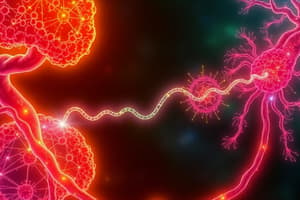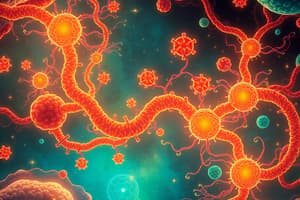Podcast
Questions and Answers
Most of the CO2 from the catabolism of glucose is released during?
Most of the CO2 from the catabolism of glucose is released during?
the citric acid cycle
Following glycolysis and the citric acid cycle, the carbon skeleton of glucose has been broken down to CO2 with some net gain of ATP. Most of the energy from the original glucose molecule at that point in the process, however, is in the form of _____
Following glycolysis and the citric acid cycle, the carbon skeleton of glucose has been broken down to CO2 with some net gain of ATP. Most of the energy from the original glucose molecule at that point in the process, however, is in the form of _____
NADH
Which electron carrier(s) function in the citric acid cycle?
Which electron carrier(s) function in the citric acid cycle?
NADH and FADH2
What happens to the rates of ATP and carbon dioxide production if one of the eight citric acid cycle intermediates is added to yeast culture?
What happens to the rates of ATP and carbon dioxide production if one of the eight citric acid cycle intermediates is added to yeast culture?
Which kind of metabolic poison would most directly interfere with glycolysis?
Which kind of metabolic poison would most directly interfere with glycolysis?
Carbon dioxide (CO2) is released during which of the following stages of cellular respiration?
Carbon dioxide (CO2) is released during which of the following stages of cellular respiration?
If glucose is the sole energy source, what fraction of the carbon dioxide exhaled by animals is generated by the reactions of the citric acid cycle?
If glucose is the sole energy source, what fraction of the carbon dioxide exhaled by animals is generated by the reactions of the citric acid cycle?
For each mole of glucose (C6H12O6) oxidized by cellular respiration, how many moles of CO2 are released in the citric acid cycle?
For each mole of glucose (C6H12O6) oxidized by cellular respiration, how many moles of CO2 are released in the citric acid cycle?
If pyruvate oxidation is blocked, what will happen to the levels of oxaloacetate and citric acid in the citric acid cycle?
If pyruvate oxidation is blocked, what will happen to the levels of oxaloacetate and citric acid in the citric acid cycle?
Starting with citrate, what products would result from three acetyl CoA molecules entering the citric acid cycle?
Starting with citrate, what products would result from three acetyl CoA molecules entering the citric acid cycle?
Flashcards are hidden until you start studying
Study Notes
Cellular Respiration Overview
- Most CO2 from glucose catabolism is released in the citric acid cycle.
- Following glycolysis and the citric acid cycle, the energy from glucose is primarily in the form of NADH before reaching the electron transport chain.
Electron Carriers
- NADH and FADH2 are key electron carriers functioning in the citric acid cycle.
Effects of Citric Acid Cycle Intermediates
- Adding citric acid cycle intermediates to yeast culture increases both ATP and CO2 production rates.
Glycolysis Interference
- Metabolic poisons mimicking glucose structure can directly disrupt glycolysis.
Carbon Dioxide Production
- CO2 is released during oxidation of pyruvate to acetyl CoA and during the citric acid cycle stages.
Carbon Dioxide Exhalation
- Animals generate two-thirds of exhaled CO2 from reactions in the citric acid cycle when glucose is the primary energy source.
CO2 Released Per Glucose Mole
- Each mole of glucose oxidized during cellular respiration releases four moles of CO2 in the citric acid cycle.
Impact of Pyruvate Oxidation Blockage
- Blocking pyruvate oxidation leads to oxaloacetate accumulation and decreased levels of citric acid in the cycle.
Outcomes of Acetyl CoA in Citric Acid Cycle
- Three acetyl CoA molecules entering the citric acid cycle yield 3 ATP, 6 CO2, 9 NADH, and 3 FADH2.
Studying That Suits You
Use AI to generate personalized quizzes and flashcards to suit your learning preferences.





